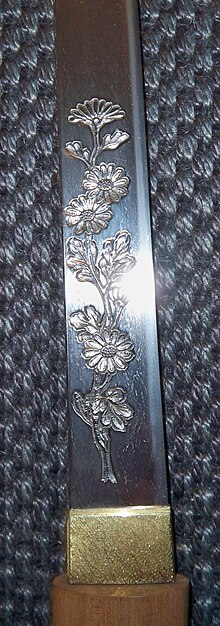Horimono
The horimono ( Japanese 彫 (り) 物 ) is an engraving on Japanese blades.
description
Many Japanese blades are decorated with engravings to improve ( Hi ) their balance or for decoration. There are various traditional motifs that are named differently. The following terms are used:
- Goma hashi ( 護 摩 箸 ): The motif depicts chopsticks as they are used on altars in Shinto shrines .
Ken ( 剣 ): The depiction of a sword - Ken or Tsurugi - as an alternative appearance of the burning deity (No. 6):
- Suken ( 素 剣 , "simple sword"): An ancient straight sword.
- Tsume ( 爪 ): The Ken with a claw ( tsume ) at the end of the handle.
Further:
- Bonji ( 梵字 ): The Bonji are Sanskrit characters . They can be shown alone or in combination with the other elements as in the illustration in connection with the Ken. The engraving is in the HI.
-
Kurikara ( 倶 利伽羅 , from Sanskrit: Kṛkara ): A dragon that winds around a sword.
- Shin-no-kurikara ( 真 の 倶 利伽羅 ): A realistically designed dragon that winds around a sword.
- Gyō-no-kurikara ( 行 の 倶 利伽羅 ): A simplified representation of a dragon that winds around a sword.
- Sō-no-kurikara ( 草 の 倶 利伽羅 ): A stylized dragon (lines) that winds around a sword.
- Kaen Fudō ( 火炎 不 動 ) also Fudō Myōō ( 不 動 明王 ): The representation of the god of the same name who is wrapped in flames ( Kaen ).
With blades that are specially made today, it is sometimes possible to have different engravings - including your own designs. Most of the time you will be offered traditional designs.
literature
- Kōkan Nagayama: The Connoisseur's Book of Japanese Swords. Kodansha International, Tokyo 1998, ISBN 4-7700-2071-6 .
- Nobuo Ogasawara: Japanese swords . 12th edition. Hoikusha, Osaka 1993, ISBN 4-586-54022-2 ( Color Books 22).
- John M. Yumoto: The Samurai Sword. A handbook . Tuttle Publishing, Rutland VT u. a. 1988, ISBN 0-8048-0509-1 .
Web links
Commons : Horimono - collection of images, videos and audio files
Individual evidence
- ↑ Tamio Tsuchiko: The New Generation of Japanese Swordsmiths. Translated by Kenji Mishina. Kodansha International, Tokyo u. a. 2002, ISBN 4-7700-2854-7 , p. 33.

